|
Lancia, one of the most
famous and evocative of all the major automotive brand names, was founded
exactly 100 years ago. To celebrate this milestone Italiaspeed is
presenting an exclusive 15 part history of Lancia.
Given Vincenzo
Lancia’s background as a renowned test and competition driver for Fiat, it is
perhaps a surprise to find that the Lancia factory did not become involved in
motorsport in a big way until the 1950s. In fairness, however, the unofficial
connection and small-scale entries were a feature of Lancia dating almost to the
start. From 1908 on, Lancias prepared by the factory had been campaigned by
Vincenzo himself – originally in a standard Alpha, and then in specially-built
‘Corsa’ versions. These exploits were followed by outings in Betas and Gammas,
but despite a number of victories, Vincenzo had abandoned competition in 1910
and further, expressly forbade the official participation of his cars in
sporting events. This decision may seem paradoxical, but actually stemmed
from his desire to concentrate all the company’s resources
on the design and construction of road cars.
Nevertheless,
even if Lancia had wished to, it would have been impossible to prevent private
owners from competing in their own cars, a point which was amply demonstrated
with the Lambda. The advanced nature of the design and in particular its
outstanding handling characteristics were quickly exploited by customers, many
of whom entered races and quickly proved the car’s sporting characteristics in a
variety of conditions. In addition to these genuinely private entries, Lancia
was unable to lose the racing bug completely, and this continued interest led to
an irregular ‘semi-unofficial’ relationship with motorsport, whereby cars were
prepared by the factory but entered by dealers or private teams. One example of
this was in the first Mille Miglia in 1927, in which six Lambdas were entered,
scoring a best position of fourth. The following year saw nine examples
entered, with one example coming home in third, while four were entered in the
1929 event, once again achieving a highest placing of fourth. The Lambda was
also put to good use in reliability trials of the era, with Mertens placing
second in the 1925 Monte Carlo Rally.
A few years
later, in 1932, an interesting ‘special’ was built for one Lancia dealer, which
featured the V8 engine from a Dilambda in the body of a Lambda. Some successes
were achieved with this until 1934, against stiff competition from Alfa Romeo. In the mid-to-late 1930s, some teams used the Astura with some success,
including a class win and tenth overall in the 1934 Mille Miglia. This car,
along with the Artena and Augusta, would help to maintain a privateer Lancia
presence in road racing events, with some excellent results on occasion, such as
Magistri’s 1500cc class win in the 1936 Targa Florio, driving an Augusta.
However, the
success in private hands enabled by the Lambda would only truly be repeated for
Lancia with the launch of the Aprilia. In the late 1930s, the new model began
to appear in competition, and considerable successes were achieved, including
class wins in the 1938 Monte Carlo Rally and Spa 24 Hours. After the end of the
war, motorsport began again to slowly be resumed, and the Aprilia again featured
for several years, including class wins in the Mille Miglia in 1947 and 1951. For all that, though, sustained factory involvement in motorsport
remained off the company’s agenda, as although the training
of an entire generation of drivers can be attributed to the
Aprilia throughout the Second World War, this was all
achieved without any official support.
This policy began
to change in 1951 with the debut of the Aurelia B20, which signalled a gradual
return to works entries under the leadership of Gianni Lancia. Initially, at
the beginning of 1951, the factory prepared four private entries for the Tour of
Sicily, although these appear to have been Aurelia B21 saloons. Although these
four cars were owned by privateers, they were fully supported by the factory,
and the result exceeded all expectations – spearheaded by ‘Ippocampo’ Castiglioni, the cars claimed the first four places in their class, defeating
the Alfa Romeo 1900s, the outstanding sports car of the period. The gauntlet
had been thrown down.
Spurred by this
early success, four production models of the Aurelia Granturismo B20 were thus
entered for the Mille Miglia. Conventional wisdom dictated that the Ferraris,
in the hands of Ascari, Villoresi, Marzotto and Serafini, would start as
outright favourites; if Lancia had any goal to aim at, it could not have been
more than a class win, given that the B20s had just half the Ferraris’ engine
capacity. In fact, by the time the competitors reached Florence on the final
run home, Villoresi would be leading the Aurelia of Bracco and Maglioli by
barely two and a half minutes. The race was only decided in the final straight
and level run to Brescia, which allowed Villoresi to claim a comfortable win,
but Bracco’s eventual second place (aided in no small part by the alleged 140
cigarettes he put away during the event) was nevertheless an outstanding
achievement, perhaps even more so than the result on the Targa Florio. The
result was confirmed with the other Aurelias coming home in fifth, seventh and
sixteenth overall. One statistic in particular was telling – Villoresi’s
average speed was 122 km/h, some 140 km/h below his car’s maximum. By contrast, Bracco’s average of 119 km/h was only 50 km/h down on the Lancia’s maximum,
which spoke volumes about the Lancia’s handling and roadholding in the tricky
wet conditions prevalent throughout the event.
A
privately-entered B20, in the hands of Bracco and Lurani, then went on to claim
victory in class and 12th overall at the Le Mans 24 Hours (a stunning
achievement considering they had never originally intended to enter), while
other excellent results included outright wins at the 1951 Pescara Six Hours
(Bracco) and the Sestrieres Rally in 1951 and 1952 (Ascari/Villoresi and
Valenzano). Enthusiasm was, understandably, sky-high – a fact reflected in the
factory’s steadily increasing commitment of both time and resources. Thus, moving into
1952, competition-prepared second-series B20s, officially entered by Lancia,
were in evidence at events such as Le Mans and the Mille Miglia. These ‘Da Corsa’ B20s were significantly modified from the production version, with
extensive weight saving (including using Plexiglass windows), lowered rooflines and
engines developing anything up to 125 bhp, which made them good for 200 km/h. These efforts met with considerable success, the most notable of which was Felice Bonetto’s triumph on the Targa Florio (heading a Lancia 1-2-3 on the
event), and third, fifth and sixth outright (plus victory in class) on a Mille
Miglia run at record pace.
Meanwhile, at the end of the season, Umberto Maglioli had taken a stunning fourth overall on the challenging Carrera
Panamericana with a B20 boosted by the addition of a Roots supercharger, taking
power to 150 bhp. Three cars were in fact so modified, driven by Bonetto,
Cabianca and Maglioli, but the latter was the only one to finish.
Works-prepared B20s also built on the private success of Bracco and Lurani by
scoring first and second in class at Le Mans, and sixth and eighth outright. In
competition terms, 1952 was indeed a great year for the marque, with Aurelias
posting astonishing giant-killing results in a multitude of arenas.
Nevertheless,
despite this success, it was the wish of Gianni Lancia to step up the factory’s
official involvement in motor racing. A true enthusiast, Gianni had a firm
belief that racing would help to boost the company’s fortunes (a point which, it
must be said, Vincenzo had never attached much store to). In fairness, this was
a wish driven partly by private drivers entering their own Lancias in
competition, who were clamouring for more power to exploit the eminently capable
chassis of the Aurelia B10. Accordingly, following a successful tacit works
entry in the 1950 Tour of Sicily, and the excellent results for
privately-entered Aurelias, Lancia and Jano took the decision in February 1952
to develop a purpose-built competition car, designed to compete in the
newly-formed World Sportscar Championship. According to the company, “The aim
now was no longer to beat Alfa Romeo only in the touring class...the team aimed
for the top: its adversaries were now Ferrari and Maserati.”
With
hindsight, we now know that the resulting D20 was
essentially a stop-gap while a much more sophisticated sports racing car was
prepared; but it nevertheless represented the culmination of a significant
amount of work and its results were certainly encouraging enough to press
forward with the programme. The D20’s coupe body retained a semblance of
the Aurelia B20’s style, and in fundamentals, the newcomer shared some points
with the production car, but virtually everything was redesigned in detail. It
retained the Aurelia’s V6 engine layout and independent rear suspension by
semi-trailing arms (albeit sprung in this case by a transverse leaf spring), but
the chassis was a brand-new tubular spaceframe reinforced by thin sheet metal
panels (in line with contemporary racing practice), with the aluminium bodywork
by Pinin Farina. Another interesting technical point introduced on this car
which would remain prominent throughout Lancia’s sportscar
programme was a transaxle which grouped the clutch, gearbox,
differential and inboard drum brakes together into a single
unit.
As well, for the first time
since the Lambda, the front suspension on a Lancia car was not of sliding pillar
type; instead, for the D20, Jano specified a system consisting of semi-trailing
arms suspended by a transverse leaf spring and struts above, with half-shafts
coupling the inboard front drum brakes to the wheels. The engine derived from
the Aurelia’s but little remained the same: although still featuring a V-angle
of 60°, it was now a 3-litre unit with four chain-driven overhead camshafts,
hemispherical combustion chambers, two spark plugs per cylinder, twin magnetos
and triple Webers, generating some 217 bhp. This was the work of Ettore Zaccone
Mina, who along with Francesco Faleo (chassis), Luigi Bosco (transmission) and
Jano, represented the cream of engineering talent which Lancia had been able to
draw on for the new car.
Apart from the
decision to press ahead with a dedicated racing car, 1952 was an important year
for the competition programme in another respect – it saw the official
foundation of ‘Scuderia Lancia’, with the now-famous galloping elephant as its
emblem, originally in blue. According to Bengt Gustavsson, the origin of this
symbol dates back to that year’s Giro di Sicilia, in which Scuderia Lancia had
first entered the competition-oriented second-series B20s. One of the drivers,
Enrico Anselmi, had used an elephant as a personal emblem on his car for some
years, and allowed the Lancia team to adopt his emblem as a team motif.
Unusually, the cars were also painted in the blue and white
of Turin, rather than traditional Italian racing red, a
colour scheme which would endure until the introduction of
the D24.
The D20 made its debut in the
1953 Mille Miglia, which saw a team of four cars entered, facing works
opposition from Ferrari, Alfa Romeo, Jaguar and Aston Martin. Bonetto and
Peruzzi’s overall third place finish in an untried and largely untested car was,
therefore, an entirely satisfactory result, especially considering the car’s
power deficit of some 70 bhp to the Ferraris and Alfa Romeos. This was followed
by success for Maglioli a couple of weeks later on the Targa Florio, an event
held in simply appalling conditions. Of ten Lancias originally entered, an
excellent all-round result was ensured by Aurelias coming in fourth, seventh and
tenth to demonstrate the potential of the new équipe, even if Taruffi had
crashed out of the lead on the last lap – a victim of the
unpredictable conditions and poor signalling from the team
who failed to correctly communicate that there was no reason
to push.
Unfortunately, circumstances would transpire to culminate in a disappointing
result at Le Mans in June. Likely thinking back to the unexpected success of Maglioli’s supercharged B20 on the Carrera
the previous year (although that had initially been to
combat the detrimental effects of high altitude and thinner
air on power output), Lancia elected to employ the principle
once again in an attempt to improve their straight-line
performance, a critical factor at the Le Mans.
|
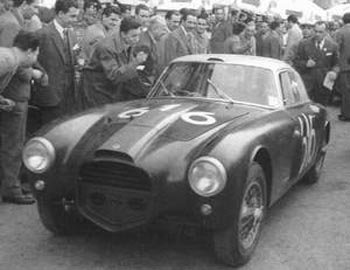 |
|
Despite being untried
and largely untested, the D20 made a successful
debut in the 1953 Mille Miglia. (Pictured:
Biondetti and Barovero, who finished eighth
overall). |
|
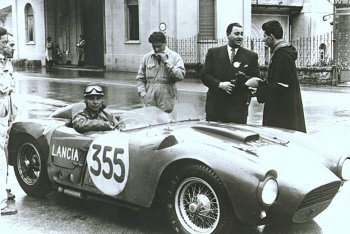
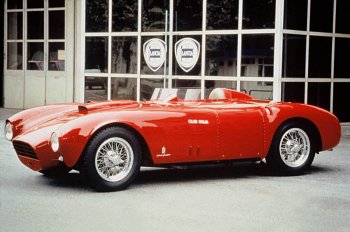
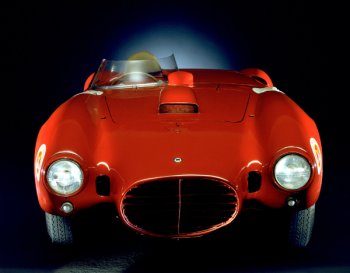
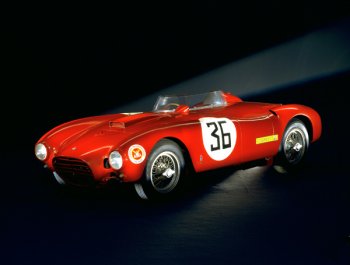
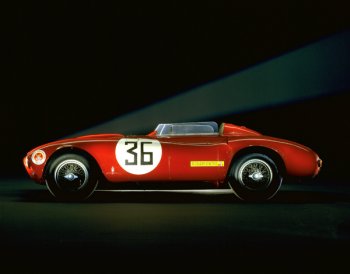
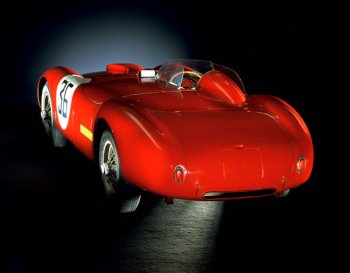 |
|
The D24 was a
significant development of the Lancia sports-racer
theme, with an engine expanded to 3.3 litres, a
redesigned transaxle and shorter wheelbase to aid
handling. It was also the most successful, with victories in the Mille Miglia, Targa
Florio and Carrera Panamericana. |
|
|
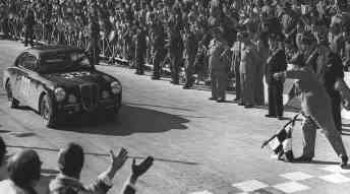 |
|
In the 1951 Mille
Miglia, Giovanni Bracco and Umberto Maglioli
finished an astonishing second overall to
Villoresi’s Ferrari in their standard Aurelia B20,
with three other Aurelias coming home in fifth,
seventh and sixteenth positions overall. |
|
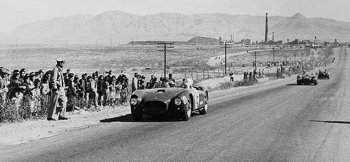
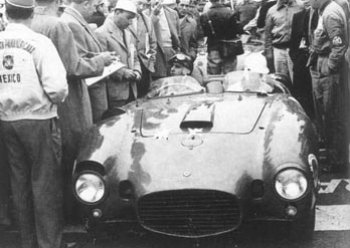
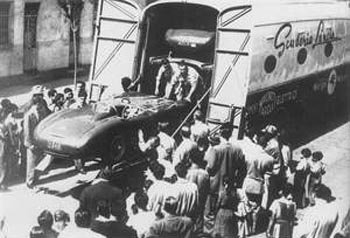
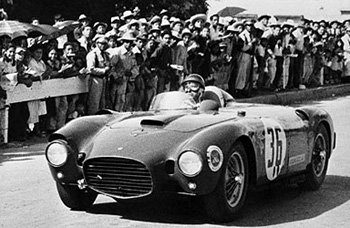 |
|
Although
overshadowed by the death of Bonetto, Lancia’s
famous 1-2-3 result on the 1953 Carrera Panamericana
was entirely deserved, and lifted the team to equal
fourth overall in that year’s World Sportscar
Championship standings. |
|
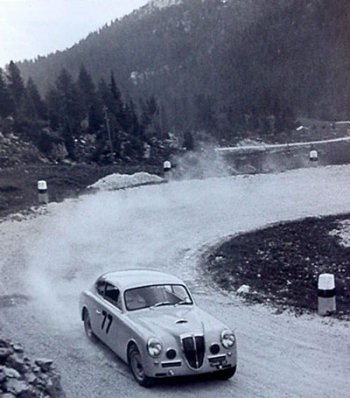 |
|
In addition to its
success in road races, the Aurelia B20 was a
formidable contender in rallies, with Louis Chiron
claiming victory in the 1954 Monte Carlo Rally.
(Pictured: Aurelia B20 contesting the Dolomite Cup). |
|
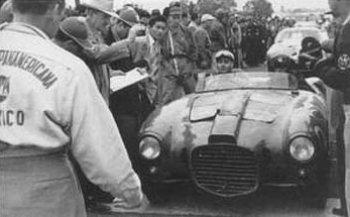 |
|
The D23
introduced the de Dion rear suspension which would
become a feature of future Lancia sports racers, and
helped Castellotti (pictured) to third overall on
the 1953 Carrera Panamericana. |
|
|
Through a 4mm reduction in bore, the engines were reduced in size to 2.7
litres, and Roots superchargers were fitted in the middle of the V. The assault
on the race would be fraught with problems, however. Firstly, the cars were
still not nearly fast enough down the Mulsanne straight – the Lancias could not
better 136 mph, while the Alfa Romeos, Jaguars and Ferraris were all capable of
cracking the 150 mph barrier. The superchargers also had an adverse effect on
reliability, with blown head gaskets accounting for two of the four entries
(generator failure sidelined the other two), in addition to which the
closed-cockpit layout was generating excessive heat and noise when combined with
the supercharged engines. Back at the factory, the supercharging experiment was
written off as a failure and the idea would not be raised
again in the context of Lancia’s sportscar programme.
Amidst this,
more concentrated development was also taking place. The excessive cockpit heat
was a serious problem and, combined with questionable aerodynamics, the simplest
solution was to simply chop off the roof, which was exactly what Lancia did. The new cars, renamed D23s, debuted at Monza for the Inter Europa Cup, where
Bonetto placed second to Villoresi’s V12 Ferrari in a decent debut.
Significantly, this event also saw the debut of an experimental de Dion rear
suspension on the D23 of Bonetto’s team-mate, Froilán González. Giving
better roadholding than the previous independent layout, this arrangement became
standard fit for all D23s from this point on and for all future Lancia sports
racers, and was also adopted on the production Aurelia the following year.
González would injure himself in practice for the Portuguese Grand Prix in
Lisbon and be unable to drive for the rest of the season, but the race saw
Bonetto claiming a first victory for the D23, leading Moss’ Jaguar from start to
finish.
Meanwhile, the
development of dedicated sports racing cars had relieved the pressure on the
Aurelia and allowed it to develop into a formidable rallycar. The B20 continued
to find success over the next few seasons, courtesy of a welcome increase in
power from the GT 2500’s larger engine – in which form it would score a couple
of important, and highly prestigious, rally wins. Over the summer of 1953,
Lancia entered four works Aurelia GT 2500 Carreras in the gruelling Liège-Rome-Liège
rally. Trow observes that these cars, “probably represented
the ultimate development of the Aurelia...with triple Solexes, lightened bodies
and special gearing, they developed about 150 bhp at 6000 rpm.” The result did
not disappoint, with Belgian Johnny Claes piloting his car to win the rally
outright, a success made even more remarkable considering that he drove the car
single-handed for 36 hours and 2400km after his co-driver Trasenster was taken
ill; Lancias also filled positions fourth through sixth. Furthermore, the B20
would score arguably its most famous rally win the following year, when Louis
Chiron took his example to victory in the Monte Carlo Rally – Lancia’s first
outright success in an event it would come to dominate a couple of decades later.
But the factory’s real focus remained sportscar racing, and in particular on an extensively revised development of the D23. With the aim of increasing power and reducing weight, whilst improving reliability, Jano had set to work on an altogether much more advanced sportscar, the D24. Ettore Zaccone had further developed the V6, such that it now developed 265 bhp at 6500 rpm from a capacity of 3.3 litres, and the transaxle had undergone a complete redesign – the gearbox was now located behind the differential in an effort to obtain more weight over the rear wheels, while the de Dion layout of the later D23s was retained. The wheelbase was also reduced to 2400mm in an effort to improve the handling and reduce weight, which compared to the D20 was now down to 860kg dry (1050kg wet, including the driver), on a par with the production C-Type Jaguar.
Such was the specification of the car which would make its debut at the Nürburgring 1000km in August, a race which marked Fangio’s debut in a Lancia. He was paired with Bonetto in one of the new machines, with Taruffi/Manzon in the second D24 and Castellotti and Bracco sharing a D23. But despite a promising start, with Taruffi and Bracco building a comfortable lead after only a few laps, the team would once again run short of luck in the race. Fangio was forced to retire due to a faulty fuel pump, and both of the other cars were sidelined with broken batteries, whose rigid mountings had shaken them to pieces.
All the same, the cars had shown much promise, and it was perhaps this which convinced Gianni Lancia to send a cost-no-object team to Mexico for the end-of-season Carrera Panamericana, a highly demanding 3000km road race which had not been especially kind to Lancia in the past. With their engines reduced in capacity to 3.1 litres for reasons of reliability, Lancia sent three D24s, plus a couple of three-litre D23s for Castellotti and Bracco, along with a veritable armada of team personnel and equipment, including an aeroplane to aid their transportation between stages. With this commitment, the famous 1-2-3 result in the more-than-capable hands of Fangio, Taruffi and Castellotti was entirely deserved, and lifted the team to equal fourth overall in the final World Sportscar Championship standings. But the result was overshadowed by the tragic death of Bonetto, who crashed on the fourth stage in a dice for the lead with
Taruffi. In Trow’s words, “in many ways (Bonetto) had come into his own with Lancia and they in turn benefited by his wide experience. He had always been a determined member of the Lancia team; little wonder he was mourned.”
Despite this tragedy, the successes would continue going into 1954. The season opened on a sour note when Taruffi and Robert Manzon were cruelly robbed of a comfortable victory at Sebring, quite literally at the eleventh hour, when the main bearings melted caused the crankshaft to shear at the flywheel. Things would improve in April, when Taruffi won the non-championship Tour of Sicily in his D24 after a last-minute decision to enter, and then, at the beginning of May, came a highly significant success. Lancia’s new signing Alberto Ascari broke Ferrari’s six-year stranglehold on the Mille Miglia to claim his and Lancia’s first and only overall win on the event, at an average of 86.7 mph in wet conditions, although he was the only one of four D24s to finish. Despite only being able to achieve 158 mph compared with the 173 mph maximum of the 375 Plus Ferraris on the long stretches which comprised the first leg, D24s had occupied the first three positions early on, but Castellotti had dropped out with mechanical problems and Taruffi had crashed out of the lead, breaking an oil pipe and the steering arm. The good result was capped by a factory-entered B20, in the hands of Gugliemo Serafini and Carlo Mancini, coming home seventh overall and first in the ‘over 1500 GT’ class.
This promising start was consolidated at the end of
the month, when Taruffi swept to victory in the Targa Florio after Castellotti
dropped out early with damaged steering. As well as being a tonic for Taruffi,
who had suffered a run of bad luck in his time with the company, this result
marked a hat-trick of wins for Lancia, an especially pleasing result as a
further four privately-entered B20s featured within the top ten finishers. In
fact, as Trow notes, the Florio’s typically twisty and demanding layout ensured
that the event was always ideally suited to Lancia’s cars, dating back to the
earliest years of the event when Lancias were placed in 1909 and again in
1911-1912.
With the painful
memories from the previous year still relatively fresh, however, Scuderia Lancia
was a no-show at Le Mans in 1954. The team knew full well that an acute lack of
horsepower had long been Lancia’s Achilles’ heel at circuits like Le Mans, and Jano had for some time been working on a new 3.8-litre version of the racing
V6. Officially, this new variant was unfortunately not ready for the June
classic, but there were perhaps other reasons for the withdrawal. According to Trow, “it was rumoured that Gianni had acquired an aversion to racing against
Jaguars”, and given the official entry of three D24s, plus anecdotal evidence of
hotel bookings being cancelled at the last minute, this story is perhaps a
partial explanation as to why cars number 18, 19 and 20 failed to make an
appearance.
Jano’s work on
the new, enlarged engine would not go totally to waste, as it was part of an
extensive package of revisions incorporated into the D25. Just slightly oversquare, with dimensions of 93mm bore and 92mm stroke, the dry-sumped 3750cc
engine now developed 295 bhp at 6500 rpm, a worthwhile improvement over the
D24. This increase in power was accompanied by a new five-speed gearbox,
outboard brakes and significant reductions in weight to just 600kg dry, giving
it an excellent power-to-weight ratio and a chance at more effectively combating
the Ferraris and Jaguars on high-speed layouts.
The D25 would
make its debut later in the month, at Oporto in Portugal. Ascari stormed around
the street circuit to take pole in the new car ahead of Hawthorn’s Ferrari, but
a blown tyre put paid to his chances; the event nevertheless resulted in a
Lancia 1-2 courtesy of the efforts of Villoresi and Castellotti in a pair of
D24s. The D25 was wheeled out once more for the International Tourist Trophy in
September, with two cars entered for Ascari/Villoresi and Fangio/Castellotti,
while a further two D24s were entered for Taruffi/Piodi and Valenzano/Manzon,
with a further D25 brought as a spare. Ascari once again claimed pole position,
but in the race itself he would collide with a wall after a dramatic dice for
the lead with Hawthorn’s Ferrari. Fangio, for his part, collected a kerb on the
opening lap, but later took over Piodi’s place in the Taruffi D24. Adjusted for
handicap, they came home fourth overall, with the second D24 sixth.
And with that,
apart from a few relatively minor domestic outings, the curtain came down on
Lancia’s involvement in fifties sportscar racing. With just a couple of
international outings to its name, the D25 was almost stillborn – a casualty of
the company’s ultimately ill-fated decision to withdraw from sportscar racing
and enter Formula 1. Both Lancia and Jano were already motor racing
enthusiasts, and it is possible that the racing success of production Lancias in
private hands had merely given them a justification to pursue the course they
had wanted to follow all along. Certainly, there was ongoing disquiet from some
elements within the company at the cost of the programme and whether the money
being expended might not better be used in investing in more factory space, for
demand was already running at the limit of existing capacity. But for the
moment, the company’s continued sporting success provided a veneer that to helped
to
conceal its mounting financial difficulties.
Furthermore, despite the promise
held by the D25, Gianni believed that Formula 1 represented, in the words of
Riccardo Felicioli, “the quickest way of giving greater visibility to the brand
and to reacquire the reputation for technical excellence with the network of
distributors and the international clientele which it had enjoyed for decades(,)
and which had somewhat faded in the recent past owing to a slight fall in
quality.” Although Lancia had finished second to Ferrari in the 1954
championship standings and the D25 looked to be an excellent prospect to lift
the title in 1955, Lancia knew that his company did not have the resources to
mount serious concurrent challenges in sportscars and Formula 1. In fact, this
was already evident, as the sportscar programme had suffered as a result of the
competition department having to divide its resources between further
development of the D24 and the new Formula 1 project, which Lancia had quietly
announced early in 1954. So it was, therefore, that on October 18, Lancia put
aside the progress it had made in sportscars, and plunged headlong into the
highly competitive world of Formula 1. The following day, the team departed
Turin, headed for Barcelona and the Spanish Grand Prix, with their brand-new F1
contender – the ‘D50’. The racing world would not have long to wait to observe
the effects of Lancia’s arrival on the established order.
by Shant Fabricatorian
|
|
|
|